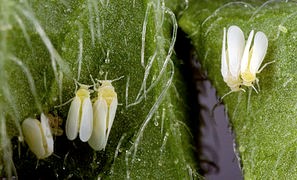
Submitted by Anonymous on Wed, 18/10/2023 - 15:12
Whitefly transmission efficiency of a potentially devastating pathogen of cassava - a staple food-source for millions across sub-Saharan Africa – is substantially higher than previously thought.
A new approach developed by the Epidemiology and Modelling Group, using model-based Bayesian methods to analyse access period experiments, is uncovering evidence for the importance of vectors of cassava viruses than previously thought. Access period experiments involve exposure of insect vectors to infected plants for set periods of feeding access.
These widely-used laboratory techniques provide insights into the role of plant-feeders in plant pathogen transmission to determine if they are an important target to control in order to minimise the spread of infections among crops.
Two avenues of virus introduction and a major threat to cassava production
Cassava mosaic begomoviruses are carried between host plants by Bemisia tabaci whitefly; but are also spread during cassava propagation in stem infection. Once cassava mosaic disease takes hold large areas of cassava can be destroyed requiring growers to source fresh cuttings – which may also harbour infection.
Figure 1 (left): Cassava mosaic viral disease, viral transmission by B. tabaci whitefly.
Figure 2 (right): Adults of B. tabaci (Rhynchota: Aleyrodidae). Image credit: USDA public domain
Unmasking Virus Retention Period
Past studies had concluded that the duration of B. tabaci retention of CMBs, and infectiousness for cassava plants, remained relatively low, leading to conclusions that whitefly played a secondary role in production area outbreaks. However, Donnelly and Gilligan found that the analysis of seminal access period experiments had not accounted for the survival of whitefly under laboratory conditions. Using Bayesian analyses they demonstrated high whitefly transmission efficiency together with low whitefly survival in the underlying experiments. The analyses point to the need to revisit findings of low transmission efficiency for additional insect-borne plant pathogens.
Read the paper:
Donnelly R, Gilligan C.A. 2023. A new method for the analysis of access period experiments, illustrated with whitefly-borne cassava mosaic begomovirus. PLOS Computational Biology 19(8): e1011291. https://doi.org/10.1371/journal.pcbi.1011291
By Alison Scott-Brown and Ruairi Donnelly, from whom more information can be obtained (rd501@cam.ac.uk)


